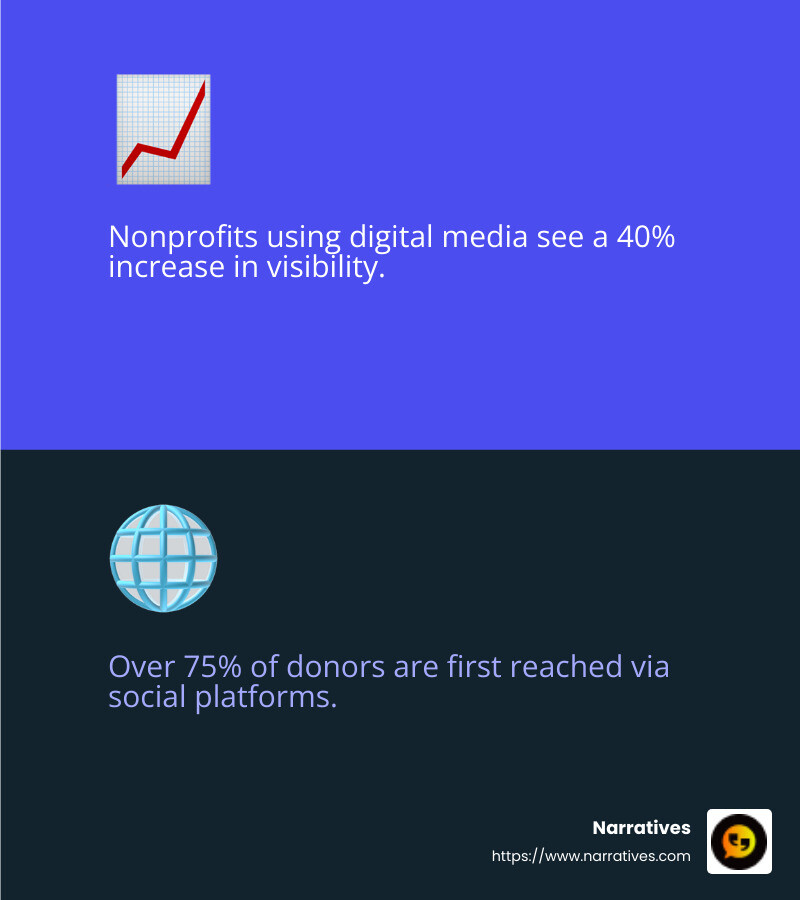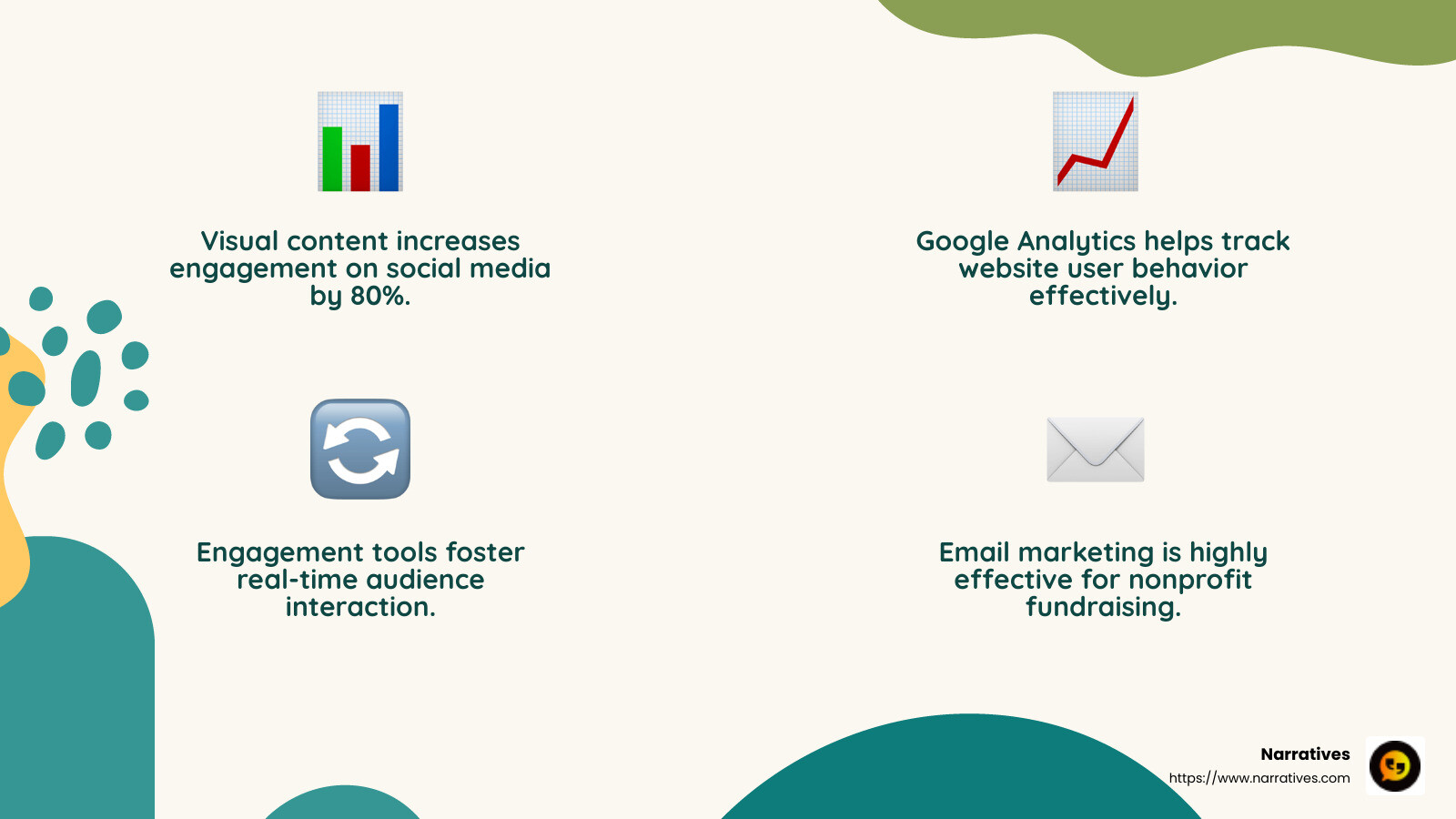Harnessing Digital Media: Nonprofit Success Stories

Digital media for nonprofits is a game-changer that allows organizations to amplify their mission, engage communities, and drive action. But with great potential comes great challenge. Here's a quick glance at what digital media can do for nonprofits:
- Increase Visibility: Reach new audiences and build awareness for your cause.
- Boost Donations: Share compelling stories that inspire giving.
- Improve Engagement: Interact with supporters in real-time, fostering a sense of community.
- Overcome Resource Limitations: Use cost-effective tools to stretch your impact.
In today's digital era, social media isn't just a platform; it's a lifeline for nonprofits. It creates opportunities for nonprofits to connect, communicate, and catalyze change like never before. With over four billion users globally, social media releasees unparalleled potential for extending reach and increasing engagement. Yet, leveraging digital media effectively isn’t without its problems.
Many nonprofits face resource constraints, from limited staff to tight budgets, making it challenging to maintain active digital media presence. Crafting compelling and consistent content requires time, creativity, and strategy—luxuries not every organization can afford. Moreover, with endless streams of user-generated content, managing feedback and reputation online can be daunting.
But here’s the promise: digital media empowers nonprofits to tell their stories, grow their communities, and fulfill their missions with authenticity and reach that were once unimaginable.

The Importance of Digital Media for Nonprofits
In nonprofits, digital media is not just a tool—it's an essential ally. This powerful medium can transform how organizations operate, engage, and grow. Here's why digital media is so crucial for nonprofits:
Increased Visibility
Digital media for nonprofits dramatically boosts visibility. Social platforms like Facebook, Instagram, and Twitter offer unprecedented reach. For instance, a nonprofit focused on mental health can use Google Ads to ensure their content appears at the top of search results when users look for related topics. This increased visibility means more people learn about the cause, leading to greater awareness and support.

More Donations
Digital media opens new avenues for fundraising. With tools like Google Ad Grants, nonprofits can access up to $10,000 per month in ad credits, allowing them to promote their mission without breaking the bank. By sharing compelling stories and showcasing impact, organizations can inspire more donations. For example, a video ad on Facebook highlighting a recent successful event can emotionally connect with viewers, encouraging them to contribute.
Improved Engagement
Engagement is the heartbeat of any nonprofit. Digital media allows for real-time interaction with supporters, fostering a sense of community and belonging. Platforms like Instagram enable nonprofits to share milestones, success stories, and behind-the-scenes glimpses, keeping supporters motivated and involved. Engaging content not only strengthens relationships with existing donors but also attracts new ones.
In summary, digital media is indispensable for nonprofits aiming to expand their reach, increase donations, and improve engagement. By leveraging these platforms effectively, organizations can amplify their impact and drive meaningful change.
Creating a Digital Media Strategy
Crafting a digital media strategy is like building a bridge between your nonprofit and its supporters. It involves setting clear social media goals, understanding your target audience, and developing a content strategy that resonates.
Social Media Goals
Start by defining what you want to achieve with digital media. Are you looking to increase awareness, raise funds, or recruit volunteers? Each goal requires a different approach. For instance, if your aim is to boost donations, your strategy might focus on storytelling and showcasing the impact of contributions.
Using the SMART framework (Specific, Measurable, Achievable, Relevant, Time-bound) can help. For example, instead of saying, "We want more followers," aim for "Increase our Instagram followers from 500 to 2,000 by the end of six months."
Target Audience
Knowing who you’re speaking to is crucial. Research your audience to understand their demographics, interests, and where they spend their time online. This will guide you in choosing the right platforms. For example, if your audience is young and visually oriented, Instagram and TikTok might be your best bets.
Create audience personas to help tailor your content. Personas are fictional characters that represent your ideal supporters. They include details like age, gender, interests, and motivations. This helps in crafting messages that connect on a personal level.
Content Strategy
A well-thought-out content strategy keeps your audience engaged and informed. Start by deciding what types of content you'll share. This could include:
- Informative posts: Share facts and statistics related to your cause.
- Storytelling: Use narratives to highlight individual stories and successes.
- Visuals: Use images and videos, as they tend to get more engagement.
Create an editorial calendar to organize your posts. Plan out themes and topics for each week or month. For example, dedicate Mondays to success stories and Wednesdays to behind-the-scenes content.
Tracking and analyzing your content's performance is vital. Use tools like Google Analytics to see what works and what doesn’t. Adjust your strategy based on these insights to keep your content fresh and relevant.
By setting clear goals, understanding your audience, and crafting a thoughtful content strategy, your nonprofit can harness the power of digital media to achieve its mission.
Top 5 Digital Media Tools for Nonprofits
In digital media for nonprofits, the right tools can make all the difference. They can save time, improve your reach, and provide insights into your performance. Here are five essential tools that can help your nonprofit thrive online.
1. Automation Tools
Automation tools are a game-changer for nonprofits with limited resources. They can help you schedule posts, manage multiple accounts, and ensure consistency across platforms.
- Jetpack Social: This tool allows you to automate your social media posting. It can share your website content directly to your social media channels and schedule posts in advance. This streamlines your efforts and keeps your audience engaged without constant manual input.
When choosing automation tools, consider ease of use, cost, and integration with your existing systems. Test out free trials or demos to find the best fit for your team.
2. Content Creation Tools
Creating engaging content is crucial for capturing your audience's attention. These tools can help you design visuals and craft compelling messages.
- Canva: A user-friendly tool for creating graphics, posters, and social media posts. It offers templates that make it easy to produce professional-looking visuals even if you’re not a designer.
Visual content tends to perform better on social media, making tools like Canva invaluable for nonprofits looking to improve their digital presence.
3. Analytics Tools
Understanding your digital media performance is key to refining your strategy. Analytics tools provide insights into what’s working and what needs improvement.
Google Analytics: A powerful tool for tracking website traffic and user behavior. It shows how visitors interact with your site, which can inform your content strategy.
Sprout Social: This tool offers detailed reports on social media performance, helping you track engagement and reach across different platforms.
Use these insights to adjust your strategy, ensuring your efforts are aligned with your goals.
4. Engagement Tools
Engagement tools help you connect with your audience and foster a sense of community.
- Hootsuite: Beyond scheduling, Hootsuite allows you to monitor conversations and engage with your audience in real-time. It’s a great way to stay on top of interactions and respond promptly to comments or questions.
5. Email Marketing Tools
Email remains a powerful channel for nonprofits. It’s personal, direct, and effective for fundraising and updates.
- Mailchimp: This tool helps you design email campaigns, manage subscribers, and track campaign performance. It’s user-friendly and offers automation features to save time.
By leveraging these tools, your nonprofit can improve its digital media strategy, engage more effectively with supporters, and ultimately drive your mission forward.

Let's now explore how to leverage social media to further amplify your nonprofit's success.
Leveraging Social Media for Nonprofit Success
Social media is a powerful ally in digital media for nonprofits. It connects you with supporters, amplifies your message, and boosts your fundraising efforts.
Fundraising Efforts
Social media can transform your fundraising strategy. With platforms like Facebook and Instagram, you can reach potential donors quickly. 55% of people who engage with causes on social media are inspired to take further action. Use this to your advantage by sharing compelling stories and clear calls to action.
- Create Donation Campaigns: Use Facebook's fundraising tools to set up donation campaigns directly on your page. This makes it easy for followers to contribute without leaving the platform.
- Share Success Stories: Post updates about how previous donations have made an impact. This builds trust and encourages more donations.
Event Promotion
Promoting events on social media can significantly increase attendance. Nonprofits can use platforms to create buzz and invite followers to participate.
- Event Pages: Create dedicated event pages on Facebook. Share all the details, post updates, and encourage followers to RSVP.
- Live Streaming: Use Instagram Live or Facebook Live to stream events. This allows supporters who can't attend in person to participate virtually.
Community Engagement
Building a strong community online is crucial for nonprofit success. Social media provides tools to engage with your audience and foster a sense of belonging.
- Interactive Content: Post polls, quizzes, and questions to engage your followers. Encourage them to share their thoughts and experiences.
- Behind-the-Scenes: Share behind-the-scenes content to give supporters a glimpse into your operations. This transparency builds trust and strengthens relationships.
By effectively leveraging social media, nonprofits can not only increase their reach but also deepen their connection with supporters. This engagement can lead to more donations, higher event attendance, and a stronger community around your cause.
Next, we'll address some frequently asked questions about digital media strategies for nonprofits.
Frequently Asked Questions about Digital Media for Nonprofits
How can nonprofits increase their reach on social media?
Increasing reach on social media is crucial for nonprofits to spread their message and gain support. Here are some straightforward strategies:
Consistent Posting: Regular updates keep your audience engaged. Aim for a consistent schedule that aligns with your audience's online habits. For example, posting during peak engagement times can boost visibility.
Engage with Your Audience: Respond to comments, ask questions, and encourage user-generated content. This interaction not only builds community but also increases your visibility in social media algorithms.
Collaborate with Influencers: Partner with influencers who share your values. Their followers trust them, and their endorsement can introduce your nonprofit to a wider audience.
Use Hashtags Wisely: Relevant hashtags make your content findable to users interested in similar topics. Research popular hashtags in your niche to maximize exposure.
What are the best practices for handling negative feedback?
Negative feedback can be challenging, but handling it well can strengthen your nonprofit's reputation. Here's how:
Stay Calm and Professional: Always respond politely and professionally, even if the comment is harsh. This shows maturity and respect for all feedback.
Acknowledge and Address: Acknowledge the issue and provide a solution or explanation. This shows that you care about your supporters' concerns.
Take It Offline: If a conversation becomes too detailed or heated, invite the person to discuss the issue privately. This can prevent public disputes and show your willingness to resolve issues.
Learn and Improve: Use feedback as an opportunity to improve. If multiple people raise the same concern, it might be worth considering changes to your approach.
How can digital media help in volunteer recruitment?
Digital media is a powerful tool for attracting and retaining volunteers. Here's how you can leverage it:
Highlight Volunteer Stories: Share stories and testimonials from current volunteers. This gives potential volunteers an idea of what to expect and the impact they can make.
Post Volunteer Opportunities: Regularly post about open volunteer positions on your social media platforms. Make it easy for interested individuals to apply or learn more.
Showcase Your Impact: Use digital media to highlight the tangible impact of your volunteers' work. This can be motivating for both current and prospective volunteers.
Create a Volunteer Community: Use platforms like Facebook Groups to create a community for your volunteers. This fosters a sense of belonging and keeps them engaged.
By using these strategies, nonprofits can effectively increase their reach, manage feedback, and recruit volunteers through digital media.
Conclusion
Narratives play a crucial role in how nonprofits connect with their audience. By focusing on storytelling, nonprofits can create emotional connections that inspire action and build trust. When we share stories that highlight the impact of our work, we not only increase visibility but also engage our community on a deeper level.
Storytelling is more than just sharing facts. It's about creating a narrative that resonates with people. Take, for example, the success of charity: water, which used compelling stories and visuals to draw attention to the global water crisis. By sharing personal journeys and authentic experiences, nonprofits can make their missions relatable and memorable. This approach can significantly improve engagement and encourage more donations and support.
Being community-driven is at the heart of every successful nonprofit. Social media offers a platform to engage with supporters, volunteers, and other organizations. By fostering a sense of belonging and collaboration, you can create a community that is invested in your mission. Highlighting the work of staff and volunteers, as well as collaborating with other nonprofits, can amplify your impact and reach.
At Narratives, we are committed to helping nonprofits harness the power of digital media to tell their stories. By elevating underrepresented voices and using high-quality multimedia content, we aim to inspire action and build lasting relationships.
For more on how we can assist your nonprofit in effective storytelling, learn more here.


